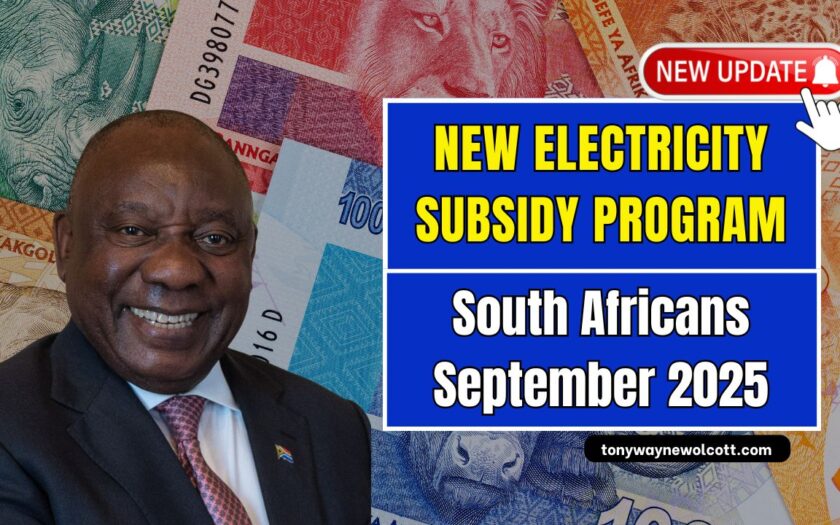South Africans, breathe easy—massive relief is arriving this September 2025. A brand‑new, comprehensive electricity subsidy program is set to roll out nationwide, promising to transform the lives of millions struggling with skyrocketing energy costs and relentless load‑shedding.
What Is the New Subsidy Program?
- Starting September 2025, the government will launch a new electricity subsidy targeted to provide affordable power to low‑ and middle‑income households.
- It aims to expand the existing Free Basic Electricity (FBE) program—currently offering just 50 kWh/month—by increasing its allowance and boosting take‑up rates.
- The initiative forms part of broader reforms: modernizing the national grid, promoting renewables, and involving independent power producers (IPPs) in expanding capacity.
Why It Matters
- Prior to this, nearly 80 percent of eligible households—an estimated 5.4 million—did not receive the FBE benefit, despite its existence since 2003. The new program aims to reverse this trend.
- With electricity prices still high and load‑shedding widespread, many families face growing hardship. This subsidy aims to ease financial stress, ensure reliable access, and improve overall quality of life.
- Strategically, it supports the national shift towards renewable energy, reduces carbon emissions, and helps stabilize South Africa’s power infrastructure.
Key Details & Figures
| Component | Details |
|---|---|
| Start Date | September 2025 |
| Expanded FBE Allowance | Greater than current 50 kWh/month |
| Households Targeted | Millions, especially currently not enrolled |
| Grid Modernization | Expanded transmission lines via the Transmission Development Plan |
| Private Investment | Encouraged through new IPP frameworks and procurement strategies |
| Renewable Energy Integration | Boost through solar, wind, battery storage, and off‑grid solutions |
| Goals | Affordable electricity, reduced load‑shedding, sustainable energy transition |
Broader Energy Reforms Context
Grid Expansion & Private Investment
A significant push is underway to modernize South Africa’s electricity infrastructure. The Transmission Development Plan includes over 14,000 km of new lines by 2032, aimed at unlocking private capital while keeping state control strong. This sets the stage for the subsidy to function effectively via improved supply lines.
Renewable Energy Momentum
Nationwide, South Africa is rapidly expanding its renewable infrastructure:
- Significant private sector capacity has been added under the Renewable Energy Independent Power Producer Programme (REIPPPP), delivering thousands of megawatts from wind, solar, biomass, and more.
- Off‑grid solar systems now number in the tens of thousands, indicating strong uptake of decentralized clean energy.
- Rooftop solar potential among commercial and industrial buildings alone could generate up to 12 GW—a figure now being actively explored through subsidies and financing frameworks.
Who Benefits Most?
- Low‑income households, especially those previously excluded from FBE, stand to gain the most.
- Middle‑income families burdened by high tariffs and frequent load‑shedding will receive meaningful relief.
- The renewables sector (including IPPs and rooftop solar promoters) benefits from stronger integration and clearer policy direction.
- In the long term, everyone gains through reduced load‑shedding, a greener energy mix, and strengthened energy security.
Challenges to Watch
While the plan is powerful, its success depends on execution:
- Ensuring the subsidy reaches the truly needy—addressing the gaps that left 80% underserved.
- Upgrading grid infrastructure quickly enough to meet increasing demand without failures.
- Balancing costs: extending subsidies while preserving fiscal responsibility.
- Coordinating across government, power utilities, IPPs, and municipalities to deliver a seamless rollout.
In September 2025, South Africa is set to roll out a bold, game‑changing electricity subsidy program aimed at unlocking big relief for millions.
By expanding Free Basic Electricity, catching up with underserved households, and coupling subsidy efforts with grid upgrades and renewable energy expansion, the government is poised to reshape the nation’s energy future.
This initiative is more than a financial relief—it’s a strategic pivot toward a resilient, affordable, and green energy system. If implemented well, it can bridge inequality, reduce load‑shedding, and power South Africa into a brighter, more sustainable era.
FAQs
How much more electricity will households get under the new subsidy?
The subsidy expands the current 50 kWh/month baseline—though the precise new allowance is still being finalized by the Department of Energy before the September 2025 launch.
Will this subsidy eliminate load‑shedding?
Not immediately. While it enhances affordability and access, lasting improvement in load‑shedding depends on expanding grid capacity through new transmission lines, IPP projects, and renewable energy investments.
Can households install rooftop solar and still benefit?
Yes. The subsidy is designed to complement renewable adoption—especially solar—by reducing upfront costs and integrating off‑grid or hybrid solutions, providing sustainable, reliable alternatives.
